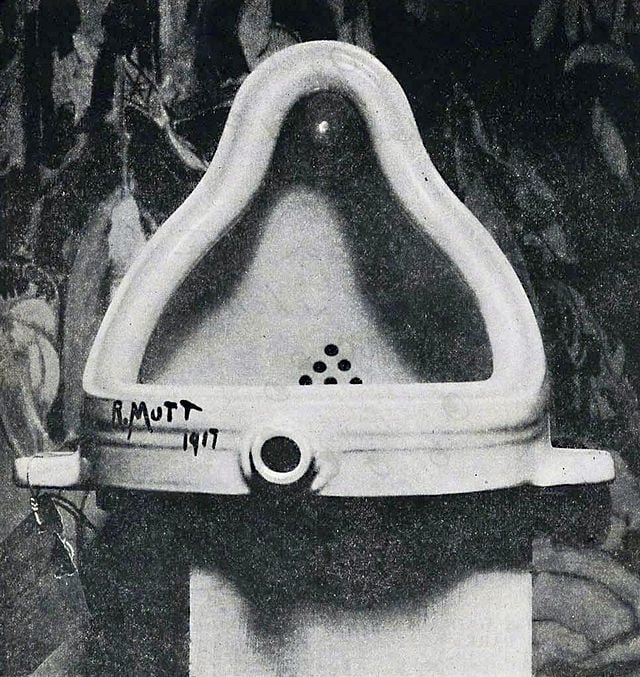
A long-running debate over the authorship of Marcel Duchamp’s Fountain has recently been reignited by two British art historians.
New research from Glyn Thompson, a former professor of art history at Leeds University, suggests that credit for this artwork was stolen by Duchamp from German Dada artist, Elsa von Freytag-Loringhoven. His findings will be included in Art Exposed, a forthcoming book by art critic and former gallery director, Julian Spalding.
Thompson presents two fresh pieces of evidence. First, he identifies the handwriting scrawled on the urinal as belonging to Von Freytag-Loringhoven, who was living and working in Philadelphia when the urinal was submitted to New York’s Society of Independent Artists exhibition in 1917. Second, he labels the urinal as a unique model made by a plumbing shop in Philadelphia—a city Duchamp never visited.
“This is the final, clinching keystone in the arch that ties the Urinal to Elsa von Freytag-Loringhoven,” Spalding said. “Duchamp could not have bought it where he much later claimed he did.”
This contradicts Duchamp’s 1996 claim that he obtained the urinal from J.L. Mott Iron Works. Thompson says the Manhattan-based company never made or sold this model and he has identified the actual urinal model that he says was submitted by Von Freytag-Loringhoven to the Society of Independent Artists exhibition. The original urinal did not survive, though it was photographed by Alfred Stieglitz after its rejection by exhibitors.
Thompson has gone so far as to track down the only two surviving examples of the same make and model. Moreover, Duchamp claimed that the “R. Mutt” inscription found on Fountain was a deliberate perversion of the J.L. Mott manufacturer’s name. But Thompson believes von Freytag-Loringhoven intended it as a pun on the German word for impoverishment, armut—something she experienced plenty of in her vibrant and too-short life.
Spalding, for his part, has long been an outspoken proponent of attributing Fountain to Von Freytag-Loringhoven. In his new book Art Exposed, published by Pallas Athene Books, he reasserts his claims that “R. Mutt” is also a reference to mutter, meaning “mother” in German. In April 1917, the month the work was submitted, the U.S. was poised to declare war against Germany and Spalding sees the writing as a desperate, if comic, plea by von Freytag-Loringhoven: “She was saying to America, ‘don’t piss on my country.’”
In light of Thompson’s latest research, Spalding believes there are seismic implications for the contemporary world of art. “The re-attribution of the Urinal to Elsa restores the meaning and power of visual creation,” Spalding said in emailed comments. “It exposes the statement that anything can be art. Art is communication or it is nothing. Elsa’s Urinal blows apart all Found Object, Conceptual Art, and the millions that have been invested in it. It’s a bubble that’s about to burst.”
Spalding and Thompson originally put forward their argument in 2014, in an article titled “Did Marcel Duchamp steal Elsa’s urinal?” that appeared in The Art Newspaper. Central to their claim at the time was a letter Duchamp wrote to his sister that said a female friend, using the pseudonym Richard Mutt, had submitted the urinal to the exhibition. The pair claim Von Freytag-Loringhoven was this friend, a suggestion first put forward by artist’s biographer, Irene Gammel.
Marcel Duchamp, Fountain, (1917). Photo: Courtesy of Tate.
This thesis was strongly disputed in a pair of articles published in Burlington Magazine in 2019 by Dawn Adès and Bradley Bailey. Adès wrote Gemmel incorrectly translated the letter to mean the urinal was sent to Duchamp personally rather than submitted to the exhibition.
“The primary weakness of [their] theory is the argument that Duchamp could not have conceived the idea or arranged for the urinal to be submitted to the Independents because no direct evidence has been presented to support that argument,” Bailey said. “It is simply too rigid of a position to defend.”
Bailey also added that it’s a “ludicrous to claim that [Thompson] has found ‘the only two’ urinals of that model in existence from the time.”
A further wrinkle in Spalding and Thompson’s argument is the address that appears on one of Stieglitz’s urinal photographs, which is connected to Louise Norton, a writer involved in Duchamp’s artistic circle. Spalding and Thompson claimed Von Freytag-Loringhoven sent the photo to Norton. Though, as Bailey revealed by publishing an interview Norton gave in 1978, Norton never met the German artist and only vaguely remembered her.
According to Adès and Bailey, it is most likely that Duchamp simply used Norton’s address to submit work. The reason for such secrecy? Duchamp was on the board of directors for the Society of Independent Artists. As Duchamp noted in that 1966 interview, he wanted to generate a scandal by resigning from the board when it rejected the urinal.
The push to posthumously credit unheralded female artists is both righteous and vital. There’s no doubt Von Freytag-Loringhoven was a gifted artist with an eye for ready-mades. But, according to Bailey, “as of this moment, there is not a single piece of direct evidence that ties the her to Fountain. Could there be one out there? Possibly. Has either Thompson or Spalding identified one? A resounding no.”
More Trending Stories:
Four ‘Excellently Preserved’ Ancient Roman Swords Have Been Found in the Judean Desert